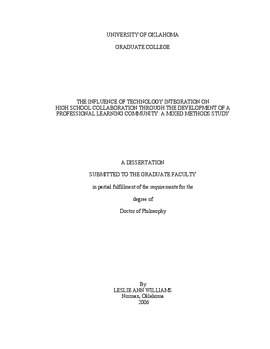| dc.contributor.advisor | O'Hair, Mary John, | en_US |
| dc.contributor.author | Williams, Leslie Ann. | en_US |
| dc.date.accessioned | 2013-08-16T12:20:10Z | |
| dc.date.available | 2013-08-16T12:20:10Z | |
| dc.date.issued | 2006 | en_US |
| dc.identifier.uri | https://hdl.handle.net/11244/1045 | |
| dc.description.abstract | Today's traditional school structures result in isolation that negatively impacts systemic school change. The school's physical organization of a collection off disconnected, separated classrooms where a group of students are assigned to a teacher reduces the opportunity for teachers to share their work with one another and is limiting because it restricts learning to the experiences of that individual (Fullan, 2001). As a result of a lack of collaboration, teachers are isolated, their practices become stagnant due to the impossibility for them to engage in productive learning with their colleagues, and the impersonality of traditional schools can lead to estrangement, alienation and a lack of meaning in individual lives. The lack of professional dialogue among educational stakeholders remains a significant impediment to the successful development of strategies to improve schools. | en_US |
| dc.description.abstract | The results of the quantitative phase demonstrated a small, positive significant correlation between the variables of the study and nine significant intercorrelations between the collaborative dimensions of professional learning communities and factors of technology integration. The results demonstrated the impact of combining collaborative professional learning communities and technology integration to increase learning and peer interactions within the community and the importance of the administrator in supporting change efforts. Within data analysis for the purposefully selected sample in the qualitative phase of the study, the themes of leadership and learning appeared. The emergence of communities of practice (Wenger, 1998) around the common concern of technology integration promoted inquiry and discourse for a collaborative school culture. Through collective learning and sharing practices, teacher leadership (Lambert, 1998) surfaced that built capacity for change in the community. The qualitative findings corroborated the quantitative results and demonstrated that collaboration in professional learning community development and technology integration were mutually influential and supportive. | en_US |
| dc.description.abstract | Data sources for this sequential explanatory mixed methods design included two survey instruments, interviews and document analysis. The data were analyzed using correlational analysis to describe the nature of the relationships in the dimensions of professional learning communities and factors of technology integration, with coded and themed qualitative data to add additional insight to the study. The results from the quantitative phase guided the interview protocol and selection of selected sites for the qualitative phase of the study. Four high schools were investigated further to determine how the schools developed and change. | en_US |
| dc.description.abstract | Recent research has documented that professional learning communities and collaboration provide schools supportive environments for continued learning and increased student achievement (Louis, Kruse & Marks, 1996; McLaughlin & Talbert, 1993; Newmann & Wehlage, 1995; Newmann, Smith, Allensworth & Bryk, 2001; Smith, Lee & Newmann, 2001). Technology can serve as a catalyst for teachers to be learners as they examine ways to integrate technology effectively into their classroom practices (Atkinson, 2005; Becker & Reil, 2000; Burns, 2002; Dexter, Seashore & Anderson, 2002). This mixed methods study investigated the relationships between collaborative professional learning community development and technology integration in a purposefully selected sample of schools. | en_US |
| dc.format.extent | xiv, 202 leaves : | en_US |
| dc.subject | Group work in education. | en_US |
| dc.subject | Education, Administration. | en_US |
| dc.subject | Communities of practice. | en_US |
| dc.subject | Computer-assisted instruction. | en_US |
| dc.subject | Educational technology. | en_US |
| dc.subject | Education, Technology of. | en_US |
| dc.title | The influence of technology integration on high school collaboration through the development of a professional learning community: A mixed methods study. | en_US |
| dc.type | Thesis | en_US |
| dc.thesis.degree | Ph.D. | en_US |
| dc.thesis.degreeDiscipline | Department of Educational Leadership and Policy Studies | en_US |
| dc.note | Source: Dissertation Abstracts International, Volume: 67-04, Section: A, page: 1182. | en_US |
| dc.note | Adviser: Mary John O'Hair. | en_US |
| ou.identifier | (UMI)AAI3214722 | en_US |
| ou.group | Jeannine Rainbolt College of Education::Department of Educational Leadership and Policy Studies | |
